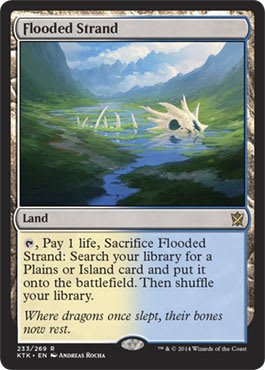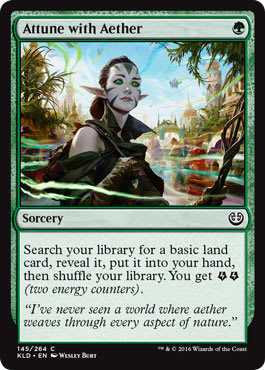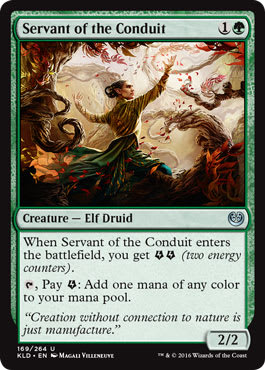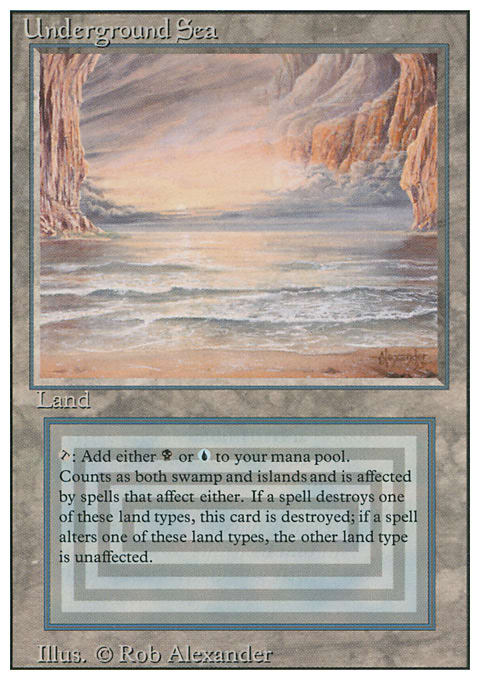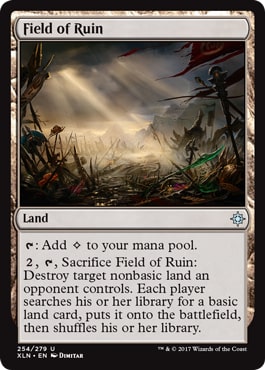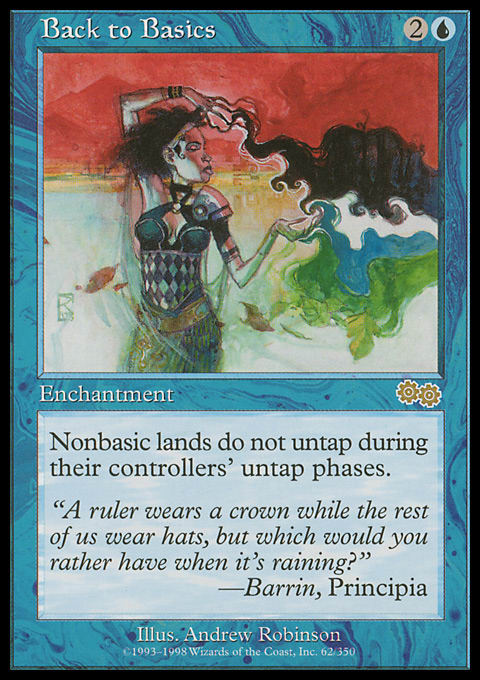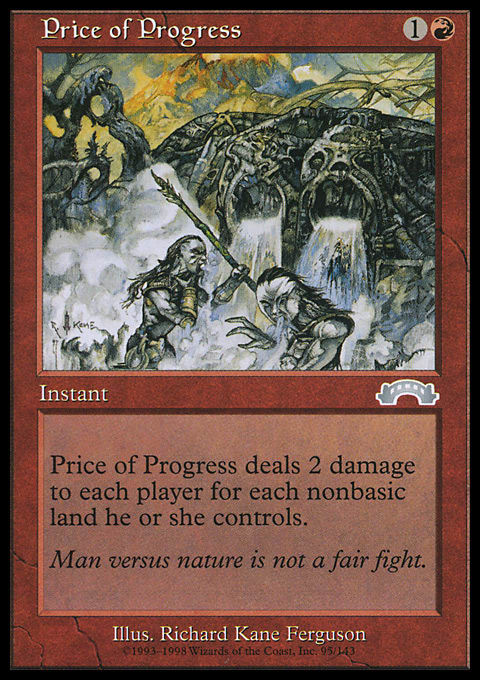Monarch and Bully are probably the ones that can switch the most easily, cutting a few nonbasic lands to make room for a few basics that can cover this. Where I really expect this to shine, though, is in some all new fresh archetypes. This is the kind of card that really enables multicolored strategies and could be enough to see a rise in three color strategies. Mana fixing options have been getting better and better and it's fully possible this is what makes it really possible. It could even be played in various two color decks for cheap card draw and fixing, even to colors where that normally wouldn't be available. Expect to see this one quite a bit over time."
This is what I wrote about Arcum's Astrolabe in my Modern Horizons Pauper set review as I tried to gauge where the card would fit into the format. By and large, the evaluations here have proven to be accurate. The only part I'd say I missed on was if it would fit into the decks that traditionally ran Prophetic Prism. While Affinity has no desire to do so, as its mana base involves artifact lands instead of snow lands, Tron and Boros decks alike found a way, shaving non-basics for a more basics-oriented package and in some cases switching from Galvanic Blast in favor of Skred.
Many other decks have started running Astrolabes as well. Bogles now runs it for different forms, Pestilence has been seen running it, as has good ol' Mystical Teachings lists. Mono-Black Control lists using Dimir Guildmage have been more than happy to play it and I've even considered running it in Elves to help with splashes for Distant Melody if it came down to it. We're even seeing a number of new decks come out with three or more colors that feel like amalgams of strategies from Tron, Delver, and Boros decks combined into one sweet package.
This seems like a good thing overall, right? It helps strategies out and allows for new decks to enter into the format. Multicolored decks have never been so viable, even with the likes of Ash Barrens and gain lands hitting the format. Unfortunately, this innocuous little card is causing some potential issues in the Pauper format that might not be easy to catch on the surface. I want to break down what's going on thanks to Arcum's Astrolabe and why I, and many others, feel it's a growing issue and why there's cause for concern.
I touched on this a little bit in one of my articles last week where I went over how the meta looks these days. If some of these points look a little familiar, this could be why. Here I'm looking to go on a deeper dive of the situation, so let's get to it:
Format Homogenization
The most immediate problem the card poses is format homogenization, or rather creating a format where everything looks similar, if not the same. Let's look at a few lists so I can better show you what I mean.
Jeskai Astro | Pauper | SamuelGraebner, MTGO Pauper Challenge 8th Place
- Creatures (17)
- 2 Archaeomancer
- 3 Trinket Mage
- 4 Glint Hawk
- 4 Kor Skyfisher
- 4 Mulldrifter
- Instants (10)
- 1 Ephemerate
- 1 Lightning Bolt
- 4 Counterspell
- 4 Skred
- Artifacts (6)
- 1 Bonesplitter
- 1 Relic of Progenitus
- 4 Arcum's Astrolabe
- Lands (19)
- 10 Snow-Covered Island
- 3 Snow-Covered Mountain
- 3 Snow-Covered Plains
- 3 Ash Barrens
- Sideboard (15)
- 1 Ephemerate
- 2 Electrickery
- 2 Weather the Storm
- 3 Molten Rain
- 3 Pyroblast
- 4 Lone Missionary
This is Jeskai Astro, one of the new variants that has popped up since the printing of Arcum's Astrolabe. You'll find a lot going on here but by and large you might notice a lot of the things Boros Monarch was doing before. By adding a third color, however, the deck has allowed for Counterspell, Mulldrifter, and even Archaeomancer to give it more as a deck. By adding in the Mulldrifters and Archaeomancers, you also get to run Ephemerate. Because of how mana intensive the deck often is, you don't want to spend three mana at a time playing Ghostly Flicker so instead, you run this cheaper, yet slower option in its stead. Because of all these new additions to the deck, the list draws so many cards trying to protect the Monarch is irrelevant and so Palace Sentinels has been dropped entirely.
This list is arguably the most popular version that you might find. Check out this other one that topped the same event:
Five-Color Astro | Pauper | Giraffe, MTGO Pauper Challenge 7th Place
- Creatures (20)
- 1 Mnemonic Wall
- 2 Guardian of the Guildpact
- 2 Trinket Mage
- 3 Seeker of the Way
- 4 Glint Hawk
- 4 Kor Skyfisher
- 4 Thraben Inspector
- Instants (11)
- 1 Ephemerate
- 1 Mystical Teachings
- 1 Pulse of Murasa
- 1 Weather the Storm
- 3 Unmake
- 4 Skred
- Sorceries (2)
- 2 Castigate
- Enchantments (1)
- 1 Pestilence
- Artifacts (6)
- 1 Prophetic Prism
- 1 Relic of Progenitus
- 4 Arcum's Astrolabe
- Lands (20)
- 1 Snow-Covered Forest
- 1 Snow-Covered Island
- 1 Snow-Covered Mountain
- 5 Snow-Covered Plains
- 5 Snow-Covered Swamp
- 1 Vault of Whispers
- 2 Orzhov Basilica
- 4 Ash Barrens
- Sideboard (15)
- 1 Dispel
- 1 Electrickery
- 1 Patrician's Scorn
- 1 Pestilence
- 1 Reaping the Graves
- 1 Relic of Progenitus
- 1 Unmake
- 1 Weather the Storm
- 2 Ancient Grudge
- 2 Hydroblast
- 3 Pyroblast
This list looks like it has a lot of the same things going on, but this time it's got a Pestilence package included. What's more, it's not just three colors - it's all five! This is basically the epitome of the greedy strategies we see here.
Astro Flicker | Pauper | sakkra, MTGO Pauper Challenge 6th Place
- Creatures (13)
- 2 Archaeomancer
- 3 Aven Riftwatcher
- 4 Augur of Bolas
- 4 Mulldrifter
- Instants (16)
- 1 Dispel
- 1 Echoing Truth
- 2 Lightning Bolt
- 4 Counterspell
- 4 Ephemerate
- 4 Skred
- Artifacts (4)
- 4 Arcum's Astrolabe
- Lands (19)
- 1 Snow-Covered Mountain
- 11 Snow-Covered Island
- 2 Snow-Covered Plains
- 1 Evolving Wilds
- 4 Ash Barrens
- Sideboard (15)
- 2 Dispel
- 2 Lone Missionary
- 2 Pyroblast
- 3 Electrickery
- 3 Hydroblast
- 3 Leave No Trace
In this list, you'll see a number of striking similarities once more to the previous two lists. The key difference here is that it's actually foregone the strategy of picking up cards with the likes of Kor Skyfisher and instead goes all in on the flicker strategy using Ephemerate. Other decks that don't focus on a three or more color strategy have however started to rely on the Skyfisher package. Take this Bogles list for example:
Astro Bogles | Pauper | Mathonical, MTGO Pauper Challenge 4th Place
- Creatures (12)
- 4 Gladecover Scout
- 4 Kor Skyfisher
- 4 Slippery Bogle
- Sorceries (2)
- 2 Commune with the Gods
- Enchantments (24)
- 4 Abundant Growth
- 4 Ancestral Mask
- 4 Armadillo Cloak
- 4 Ethereal Armor
- 4 Rancor
- 4 Utopia Sprawl
- Artifacts (4)
- 4 Arcum's Astrolabe
- Lands (18)
- 16 Snow-Covered Forest
- 2 Snow-Covered Plains
- Sideboard (15)
- 1 Electrickery
- 1 Gorilla Shaman
- 1 Gut Shot
- 1 Journey to Nowhere
- 1 Relic of Progenitus
- 2 Crimson Acolyte
- 2 Dispel
- 2 Fling
- 2 Lifelink
- 2 Standard Bearer
Bogles historically has gained its notoriety as a strong deck because none of its creatures could be easily dealt with outside of using a Chainer's Edict or the like. Turning on your opponent's removal spells like Lightning Bolt is something you actively didn't want to be doing unless you were getting good value out of the deal. Before, you would play Heliod's Pilgrim to find your best aura for the current situation and then you don't care if it dies or not.
Now you just play Kor Skyfisher instead. Playing Skyfisher allows you to pick up an Astrolabe or Abundant Growth and replay it for extra card draw. This is why most of these decks are playing some number of Skyfishers: it's effectively a better Mulldrifter thanks to the printing of Arcum's Astrolabe. By playing Astrolabe, then Skyfisher, and then Astrolabe again, you get a 2/3 Mulldrifter for effectively ![]()
![]() that stays on the board permanently.
that stays on the board permanently.
Even Tron decks have gone full greedy with Skyfisher and Astrolabe:
Astro Tron | Pauper | billster47, MTGO Pauper Format Playoff 2nd Place
- Creatures (14)
- 2 Palace Sentinels
- 4 Glint Hawk
- 4 Kor Skyfisher
- 4 Mulldrifter
- Sorceries (9)
- 1 Weather the Storm
- 3 Prismatic Strands
- 2 Deep Analysis
- 3 Kaervek's Torch
- Enchantments (4)
- 4 Journey to Nowhere
- Artifacts (12)
- 1 Relic of Progenitus
- 3 Expedition Map
- 4 Arcum's Astrolabe
- 4 Prophetic Prism
- Lands (21)
- 2 Snow-Covered Island
- 4 Snow-Covered Plains
- 3 Ash Barrens
- 4 Urza's Mine
- 4 Urza's Power Plant
- 4 Urza's Tower
- Sideboard (15)
- 1 Kor Sanctifiers
- 1 Prismatic Strands
- 1 Standard Bearer
- 1 Weather the Storm
- 2 Dispel
- 2 Electrickery
- 2 Hydroblst
- 2 Relic of Progenitus
- 3 Pyroblast
This is what a true merger between the Boros Monarch and Tron archetypes looks like. Boros was always a fairly mana intensive deck and this takes it to the extreme, killing with both tons of flying creatures and Kaervek's Torches. All the while, it ups the ante on the draw engines by featuring not just Mulldrifter but also Deep Analysis.
The other Tron lists that we've seen lately look more like your normal Removal Tron, Murasa Tron, Fog Tron, etc. but with Astrolabes mixed in to add more color consistency. In total, this past week's Magic Online Challenge had 24 out of a possible 32 Astrolabes in the Top 8. Even more were in the Top 16. This is a really bad sign if this continues as it's similar to the numbers other cards showed before they too were banned out of the format. Even if their power level was higher than something that's just a glorified mana filter, in the context of the Pauper format, what's going on feels somewhat alarming.
Many of these decks look by and large the same, or at least at the core of what they're doing, which is a sign of homogenization. We've seen this issue a lot not just in Pauper, but in the likes of Standard as well. That leads me into my second point.
The Perfect Mana Problem
The root of the issue is that Arcum's Astrolabe, especially when in conjunction with the likes of Prophetic Prism and/or Ash Barrens, creates a situation where perfect mana is completely possible. To many, this opens a world of possibilities and in their eyes creates the potential for unlimited diversity. In reality, what happens is people start taking the best good stuff piles they can and combining them together.
A great recent example of this is what we saw in the Standard environment where Khans of Tarkir block and Battle For Zendikar block were legal together. If you played during this time, you may remember how the combination of fetch lands and the battle (or tango) lands created a swath of different decks. The problem was they were by and large doing the same thing, simply stuffed to the brim with all the good stuff the format could handle. This drove decks upward of $1000 between top-tier mana, planeswalkers, and so on.
The cost wasn't the only issue that concerned players though. While there was certainly a level of freshness and novelty that these good stuff decks brought with them, players rapidly found them boring. They were all starting to do the same thing and it got dull fast. Thankfully, players didn't have to wait too long, as Khans of Tarkir (along with Fate Reforged) rotated out of the format when Shadows Over Innistrad was released. This meant that players only had to endure this stagnated format for a few short months, making a ban pointless.
While perfect mana wasn't quite as big of a deal in this kind of format, we did also see a lot of the same feelings emerge when Temur Energy was rampant during Kaladesh Standard. That deck too had multiple variations that all felt the same and was far and away the best deck. This had persisted for quite awhile and while some decks could squeeze into the meta, it was basically play Temur Energy, or some variant thereof, or lose.
On a bit of an older point, we did also see a wild format of perfect mana during the period when Lorwyn block was legal. The reason for this was the combination of the Vivid lands, such as Vivid Creek, with Reflecting Pool. This wasn't quite as homogenized as formats like the aforementioned ones, but still saw plenty of multicolored good stuff lists revolving around this perfect mana base. This was especially exacerbated by the fact that the Shards of Alara block in particular was a multicolored block itself.
So now that we've seen what this can be like in Standard, what about in other formats, like Modern and Legacy? After all, those have the best mana options around and then some. Modern has the possibility for an even better version of the Khans/BFZ mana base thanks to the shock lands. Legacy is even more of an issue at face value thanks to the original dual lands. What makes these different from the aforementioned Standard environments is one simple thing: answers. Which leads me into my next point about Arcum's Astrolabe:
It's Difficult to Attack
In each of the above environments, hitting the mana was tough. Khans/BFZ had no good land destruction effects and Kaladesh benefitted especially from Energy being completely impossible to interact with. The only reason it wasn't so oppressive in Lorwyn was because a lot of times it was actually best to just run a two-color deck, so there was little point in running the full gamut of colors. Still, the decks were strong and everywhere, and once again with no real way to be answered properly.
Modern, however, has the following answers:
Each of these cards individually attacks non-basic lands and takes them out. Often times, it's not uncommon to see a deck run only a small handful of actual basics, so it's not hard to hit them down enough times for your Ghost Quarters and Path to Exiles into outright land or creature destruction with zero drawback. It's no coincidence as well that Blood Moon is one of the format's biggest boogiemen, punishing the greed that many players try in the meta.
It's even harsher in Legacy where you have these cards as well to fight back against non-basics:
Essentially these two formats (and Vintage, should you want to count it) have the tools and the answers necessary to fight back against such greedy mana bases. Unfortunately these checks and balances don't really exist in Pauper in the wake of Arcum's Astrolabe, much like the Standards of the past with perfect mana.
In some ways, Astrolabe is even worse, as it not only gives you the perfect mana to do the format's best things, but it also draws you a card. This means that at the very best, you'll often be burning a card to destroy the mana filtration device and your opponent will still be up a card. As it often happens, though, it's more likely your opponent will have bounced and replayed the Astrolabe multiple times before you destroy it, meaning they're far outracing you, even if you take them off their mana somewhat.
How do you answer it? Countermagic only goes so far, and Spellstutter Sprite is showing up less than ever. Even if it does appear, it gets killed or countered fast and the Astro player's strategy still goes through. I have seen some calls of metagaming by Burn players to run Smash to Smithereens in the main deck. That's a tremendously unhealthy sign for the state of the format made all the worse by just how much sense it actually makes.
In addition to all this, there's one last point to make here:
The Overall Decks are Harder to Attack
Like Modern and Legacy, Pauper has for a long time been somewhat easy to identify what was coming your way based on the very first land your opponent dropped. If they played a Thornwood Falls, for example, odds were strong they were either on a Tron variant or else on Turbofog. If you saw Scoured Barrens you braced yourself for Pestilence . A regular Island meant Mono-Blue Delver while a Snow-Covered one likely meant Izzet Delver.
There was a lot of play to determine what was what and I'm concerned a lot of that is now disappearing. With the fresh advent of Arcum's Astrolabe combined with Ash Barrens, Evolving Wilds, and/or Terramorphic Expanse there's no longer a need for these dual lands anymore. It's simply easier, and almost always better, just to run the Snow-Covered basics. Even if you're a mono-color strategy that isn't running any more beyond that, it's usually just best to run the Snow-Covered lands to make your opponents think you are.
The problem with this is it actually makes your opponents' decks more difficult to identify. Are they on Izzet Delver? Boros Monarch? Are they on Jeskai Astro or are they on Five-Color? Is their list running the Ephemerate package? What about Prismatic Strands? After all, nowadays some lists run the card while others don't.
Because of these lands, it's next to impossible to know what your opponent is doing or what their lists look like. In the past, you could pull up a list and know exactly what your opponent was running, give or take five cards, assuming they weren't on some extremely rogue build. You still can do this for a few archetypes like Elves, but it's getting harder and harder as the decks, and especially the mana bases, begin to look the same.
In addition, while not necessarily something that takes away from actual core gameplay, the fact that you must run Snow-Covered basics takes away from deck personalization. It does this by limiting the card arts you can use, meaning you can't run your sweet Beta basics, or your Guru lands, or your random Odyssey art of choice. While not the biggest thing for some, this takes away from something fundamentally enjoyable to a number of players of the game. Even if it's tremendously small, I see that as at least a part of the problem.
So what now?
The Banned and Restricted Announcement for Core Set 2020 came and went, seeing only the card Bridge From Below banned in Modern. We knew ahead of time, however, that we wouldn't be seeing any bans in Pauper following the format unification as Ian Duke had stated so during the announcement video for that. The next B&R Announcement comes on August 26th.
Do I think Arcum's Astrolabe should be banned? Maybe. I don't think it's as cut and dry as Gush felt right before it was nuked out of the format. I also think it's too early in the card's lifecycle to outright ban it. When I wrote my piece Shaking The Pillars about cards needing to be banned in the format, it was roughly only six weeks after the release of Ultimate Masters and the adding of Foil to the format. Similarly, it's only been about six weeks since Modern Horizons entered the format.
The difference here is that when Foil came onto the scene, we were already long dealing with the issues I cited in the aforementioned article. A lot of the warning signs were there, but it was believed there would be a natural ebb and flow as the format once had in the past. The printing of Foil just made it worse on an immediate level that was easy to identify and sound the alarm about.
With Arcum's Astrolabe, however, it's a totally new thing that's completely changed the face of the metagame. It's hard to say if it's still not fully settled, if it's going to get better, or if it gets worse. Having seen how the meta is looking, and especially the top of this most recent Magic Online Pauper Challenge, I'm not exactly holding out hope it'll get better. If it does continue down this path, it's very likely Astrolabe will have to go, or possibly something like Kor Skyfisher as some have suggested.
Myself, I really hope the format can settle into a format that doesn't lean in so heavily on extremely greedy Astrolabe strategies that largely play the same. The card is both powerful and cool and I was actually genuinely excited to see it in spoiler season. Writing that it's a problem, especially for what's essentially a glorified mana rock, feels a bit wrong, but it's also the realistic nature of the situation. Time will ultimately tell on this one.
If you're unable to check out much, if any, Pauper content using Arcum's Astrolabe and haven't had a chance to see it in action, we'll have some gameplay with it tomorrow during the Pauper Premiere League! Check back here on CoolStuffInc.com at 11am EST and you'll see an article with all the week's decklist. Don't forget to throw the CoolStuffInc Twitch page a follow and get notified when the action starts at 9pm EDT!


















